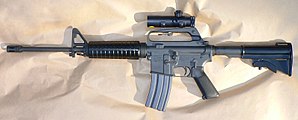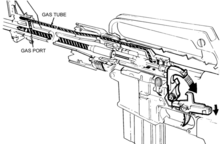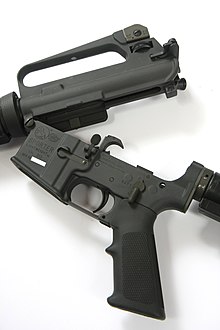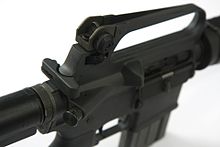Colt AR-15: Difference between revisions
| [pending revision] | [pending revision] |
| Line 37: | Line 37: | ||
The '''Colt AR-15''' is a lightweight, [[5.56×45mm]], magazine-fed, gas-operated [[semi-automatic rifle]]. It was designed to be manufactured with the extensive use of aluminum alloys and synthetic materials. It is a semi-automatic version of the United States military [[M16 rifle]]. [[Colt's Manufacturing Company]] currently uses the '''AR-15''' trademark for its [[List of Colt AR-15 & M16 rifle variants#Numbered Colt civilian models|line of semi-automatic AR-15 rifles]] that are marketed to civilian and law-enforcement customers. |
The '''Colt AR-15''' is a lightweight, [[5.56×45mm]], magazine-fed, gas-operated [[semi-automatic rifle]]. It was designed to be manufactured with the extensive use of aluminum alloys and synthetic materials. It is a semi-automatic version of the United States military [[M16 rifle]]. [[Colt's Manufacturing Company]] currently uses the '''AR-15''' trademark for its [[List of Colt AR-15 & M16 rifle variants#Numbered Colt civilian models|line of semi-automatic AR-15 rifles]] that are marketed to civilian and law-enforcement customers. |
||
In the 2010s, the AR-15 and [[AR-15 style rifle|its variants]] became one of the "most beloved and most vilified rifles" in the United States, according to the ''[[New York Times]]''.<ref name="NYT 13 June 2016">{{cite news|last1=Feuer|first1=Alan|title=AR-15 Rifles Are Beloved, Reviled and a Common Element in Mass Shootings|url=https://www.nytimes.com/2016/06/14/nyregion/ar-15-rifles-are-beloved-reviled-and-a-common-element-in-mass-shootings.html|accessdate=16 February 2018|work=The New York Times|date=13 June 2016}}</ref> It has been the weapon used in many [[mass shooting]]s, and has been promoted as "America's rifle" by the [[National Rifle Association]].<ref name="NYT 13 June 2016" /> Several million are estimated to be in circulation in the United States.<ref name="NYT 13 June 2016" /> |
|||
==History== |
==History== |
||
Revision as of 01:51, 20 February 2018
| Colt AR-15 | |
|---|---|
 A carbine variant of the Colt AR-15 | |
| Type | Semi-automatic rifle |
| Place of origin | United States |
| Service history | |
| In service | 1963–present |
| Production history | |
| Designer | Eugene Stoner, Jim Sullivan, Bob Fremont |
| Manufacturer | Colt |
| Variants | see List of Colt AR-15 & M16 rifle variants |
| Specifications | |
| Barrel length |
|
| Cartridge | |
| Action | Direct impingement |
| Effective firing range | ~550 metres (600 yd) |
| Feed system | Issued with 5-, 10-, 20- & 30-round STANAG magazines |
| Sights |
|
The Colt AR-15 is a lightweight, 5.56×45mm, magazine-fed, gas-operated semi-automatic rifle. It was designed to be manufactured with the extensive use of aluminum alloys and synthetic materials. It is a semi-automatic version of the United States military M16 rifle. Colt's Manufacturing Company currently uses the AR-15 trademark for its line of semi-automatic AR-15 rifles that are marketed to civilian and law-enforcement customers.
History


Colt started selling the semi-automatic version of the M16 rifle as the Colt AR-15 in 1964.[1][2][3] The first mass production version was the Colt AR-15 Sporter, in .223 Remington, with a 20-inch barrel and issued with 5-round magazines.[4] Over the decades, Colt has made many different types of AR-15 rifle and carbine models, including the AR-15, AR-15A2, AR-15A3, AR-15A4, and many other models.
The National Rifle Association, a national gun rights advocacy organization, calls it "America's rifle".[5] AR-15 variants are frequently used in mass shootings in the United States,[5] including in the 2012 Sandy Hook Elementary School shooting, 2012 Aurora shooting, 2015 San Bernardino attack[5] and 2018 Stoneman Douglas High School shooting.[6]
Operating mechanism

U.S. patent 2,951,424 describes the cycling mechanism used in the original AR-15. The bolt carrier acts as a movable cylinder and the bolt itself acts as a stationary piston. This mechanism is often called "direct gas impingement" (DGI), although it differs from prior gas systems. Designer Eugene Stoner did not consider the AR-15 to be a conventional direct impingement mechanism, but that is how it came to be characterized.[7]
Gas is tapped from the barrel as the bullet moves past a gas port located above the rifle's front sight base. The gas expands into the port and down a gas tube, located above the barrel that runs from the front sight base into the AR-15's upper receiver. Here, the gas tube protrudes into a "gas key" (bolt carrier key), which accepts the gas and funnels it into the bolt carrier.
At this point, the bolt is locked into the barrel extension by locking lugs, so the expanding gas forces the bolt carrier backward a short distance. As the bolt carrier moves toward the butt of the gun, the bolt cam pin, riding in a slot on the bolt carrier, forces the bolt to rotate and thus unlocks it from the barrel extension. Once the bolt is fully unlocked it begins its rearward movement along with the bolt carrier. The bolt's rearward motion extracts the empty cartridge case from the chamber. As soon as the neck of the case clears the barrel extension, the bolt's spring-loaded ejector forces it out the ejection port in the side of the upper receiver.
Behind the bolt carrier is a plastic or metal buffer, which rests in line with a return spring. The buffer spring begins to push the bolt carrier and bolt back toward the chamber once it is compressed sufficiently. A groove machined into the upper receiver guides the bolt cam pin and prevents it and the bolt from rotating into a closed position. The bolt's locking lugs push a fresh round from the magazine as the bolt moves forward. The round is guided by feed ramps into the chamber. As the bolt's locking lugs move past the barrel extension, the cam pin twists into a pocket milled into the upper receiver. This twisting action follows the groove cut into the carrier and forces the bolt to twist and "lock" into the barrel extension.
Features




Upper receivers
The upper receiver incorporates the fore stock, the charging handle, the forward assist, the gas operating system, the barrel, the bolt and bolt carrier assembly. AR-15s employ a modular design. Thus one upper receiver can quickly and easily be substituted for another. Upper receivers are available with barrels of different weights, lengths, calibers, and rail systems with various sights and accessories. The standard AR-15 rifle uses a 20" barrel. Although, both shorter 16" carbine barrels and longer 24" target barrels are also available.
Early models had barrels with a 1:12 rate of twist for the original 223 Remington, 55 grain (3.6 g) bullets. Current models have barrels with a 1:9 or 1:7 twist rate for the 5.56×45mm NATO, 62 grain (4 g) bullets.
Lower receivers
The lower receiver incorporates the magazine well, the pistol grip, the buttstock, the buffer and the buffer spring. The lower receiver also contains the trigger, disconnector, hammer and fire selector (collectively known as the fire control group). Full-sized rifles use a fixed buttstock, while carbines generally use an adjustable telescoping buttstock.
The early commercial SP-1 AR-15s used a pair of .250" diameter receiver push pins, identical to those found on the military rifles. In 1966 the company replaced the front pin with a paired nut and screw hinge using a .315" diameter pin to prevent shooters from being able to change receivers with military rifles or competitor rifles without the use of an adapter. They resumed production with the smaller and standardized .250" pin in the mid-1990s.[8]
Sights
The AR-15's most distinctive ergonomic feature is the carrying handle and rear sight assembly on top of the receiver. This is a by-product of the original ArmaLite design, where the carry handle served to protect the charging handle.[9] As the line of sight is 2.5 in (63.5 mm) over the bore, the AR-15 has an inherent parallax problem. At closer ranges (typically inside 15–20 meters), the shooter must compensate by aiming high to place shots where desired. The standard AR-15 rifle has a 500 mm (19.75 inches) sight radius.[10] The AR-15 uses an L-type flip, aperture rear sight and it is adjustable with two settings, 0 to 300 meters and 300 to 400 meters.[11] The front sight is a post adjustable for elevation. The rear sight can be adjusted for windage. The sights can be adjusted with a bullet tip or pointed tool. The AR-15 can also mount a scope on the carrying handle. With the advent of the AR-15A2, a new fully adjustable rear sight was added, allowing the rear sight to be dialed in for specific range settings between 300 and 800 meters and to allow windage adjustments without the need of a tool or cartridge.[12] Current versions such as AR-15A4 use Picatinny rails, which allows the use of various scopes and sighting devices.
Muzzle devices
Colt AR-15 rifles most often have a barrel threaded in 1⁄2"-28 threads to incorporate the use of a muzzle device such as a flash suppressor, sound suppressor or muzzle brake. The initial design, the "duckbill," had three tines or prongs and was prone to breakage and getting entangled in vegetation. The design was later changed to close the end to avoid this problem. Eventually, on the A2 version of the rifle, the bottom port was closed to reduce muzzle climb and prevent dust from rising when the rifle was fired in the prone position.[13] For these reasons, the US military declared this muzzle device a compensator, but it is more commonly known as the "GI", "A2", or "Birdcage" muzzle device.[14] The standard AR15 muzzle device conforms to the STANAG dimensional requirements for firing 22mm rifle grenades.
Magazines
The Colt AR-15 uses 20- or 30-round staggered-column detachable box magazines. Low-capacity 5- or 10-round magazines are also available to comply with legal restrictions, for hunting, for benchrest shooting or where a larger magazine can be inconvenient.
AR-15 style rifle

After Colt's patents expired in 1977,[15] other manufactures began to copy the Colt AR-15 rifle's design. However, the term "AR-15" is a Colt registered trademark and Colt only uses the term to refer to its line of semi-automatic rifles. Therefore, other manufacturers began to market their generic AR-15s under separate designations, although these are all frequently referred to as AR-15s--for instance, the perpetrator of the Orlando nightclub shooting was described as having used an "AR-15-type assault rifle", in the words of the Orlando police chief, even though Omar Mateen actually used a SIG Sauer MCX.[16]
AR-15 type rifles are available in a wide range of configurations and calibers from a large number of manufacturers. These configurations range from standard full-sizes rifles with 20-inch barrels, to short carbine-length models with 16-inch barrels, adjustable length stocks and optical sights, to long range target models with 24-inch barrels, bipods and high-powered scopes. These rifles may also have short-stroke gas piston system, forgoing the direct gas system standard in AR-15 rifles. These calibers include the 5.56×45mm NATO, 5.7×28mm, 6.8mm Remington SPC, .300 Blackout, 9×19mm Parabellum and .458 SOCOM to name a few.[17][18]
Gallery
-
Complete AR-15A2 rifle set with manual, 5.56mm ammo and magazines
-
AR-15A2 charging handle, forward assist, cartridge case deflector, magazine release and dust cover
-
AR-15A2 fire control group, bolt release and fire selector
-
AR-15A2 fire selector and bolt release
-
AR-15A2 fire selector (set to FIRE)
-
AR-15A2 front sight
-
AR-15 fixed stock showing the buffer and the buffer spring
-
AR-15 buttstock showing cleaning kit compartment door
-
AR-15 cleaning kit stowed in buttstock
-
AR-15A2 flash hider
-
AR-15 bolt
-
AR-15 bolt carrier, firing pin, cam pin, and firing pin retaining pin
See also
References
- ^ Zimba, Jeff. "The Evolution of the Black Rifle". Small Arms Review. Retrieved November 14, 2017.
As early as 1963, Colt started manufacturing this "new" rifle in semiautomatic only with the civilian population and the law enforcement community in mind. Sold as the AR-15 Sporter it was virtually identical to the M16 with the exception of the fire control group.
- ^ Bob Hutton & Bob Forker (October 1964). "A Beautiful Marriage: .223 Remington and Colt's AR-15 'Sporter'". Guns & Ammo.
- ^ Mann, Richard A. (April 30, 2014). GunDigest Shooter's Guide to the AR-15. Iola, Wisconsin: Krause Publications. pp. 15–16. ISBN 978-1-4402-3847-5.
- ^ Bob Hutton & Bob Forker (October 1964). "A Beautiful Marriage: .223 Remington and Colt's AR-15 'Sporter'". Guns & Ammo.
- ^ a b c Feuer, Alan (June 13, 2016). "AR-15 Rifles Are Beloved, Reviled and a Common Element in Mass Shootings". The New York Times. Retrieved February 16, 2018.
- ^ Shapiro, Emily (February 14, 2018). "At least 17 dead in 'horrific' Florida school shooting, suspect had 'countless magazines'". ABC News. Archived from the original on February 15, 2018. Retrieved February 15, 2018.
{{cite news}}: Unknown parameter|deadurl=ignored (|url-status=suggested) (help) - ^ 'Gun Digest Guide to Customizing Your AR-15
- ^ Sweeney, Patrick (October 1, 1999). Gunsmithing - Rifles. Iola, Wisconsin: Gun Digest Books. p. 290. ISBN 0-87341-665-1.
- ^ Ezell, Edward Clinton (1983). Small Arms of the World. New York: Stackpole Books. pp. 746–762. ISBN 978-0-88029-601-4.
- ^ "M16 5.56mm Rifle". Archived from the original on June 16, 2011. Retrieved October 7, 2012.
{{cite web}}: Unknown parameter|deadurl=ignored (|url-status=suggested) (help). colt.com. Retrieved on 8 October 2011. - ^ Operator's Manual For M16, M16A1. Archive.org. Retrieved on 27 September 2011.
- ^ Venola, Richard (2005). "What a Long Strange Trip It's Been". Book of the AR-15 1 (2): 6–18.
- ^ Wieland, Terry (November 22, 2011). Gun Digest Book of Classic American Combat Rifles. Iola, Wisconsin: Krause Publications. p. 100. ISBN 978-1-4402-3017-2.
- ^ Steve Crawford (2003). Twenty First Century Small Arms: The World's Great Infantry Weapons. Zenith Imprint. pp. 85–86. ISBN 978-0-7603-1503-3. Retrieved May 28, 2013.
- ^ Zimba, Jeff (November 26, 2014). "The Evolution of the Black Rifle: 20 Years of Upgrades, Options, and Accessories". Prepper Press – via Google Books.
- ^ Walker, Rob (December 30, 2016). "The Year in Nine Objects". The New Yorker. ISSN 0028-792X. Retrieved November 6, 2017.
- ^ U.S. Military Small Arms Ammunition Failures and Solutions, GK Roberts, NDIA Dallas, TX, May 21, 2008 "Archived copy" (PDF). Archived from the original (PDF) on June 28, 2011. Retrieved February 4, 2011.
{{cite web}}: Unknown parameter|deadurl=ignored (|url-status=suggested) (help)CS1 maint: archived copy as title (link) - ^ Evolution of an AR | Gear | Guns & Ammo Archived September 15, 2011, at the Wayback Machine. Archives.gunsandammo.com (August 29, 2011). Retrieved on 2011-09-27.
Bibliography
- Stevens, R. Blake and Edward C. Ezell. The Black Rifle M16 Retrospective. Enhanced second printing. Cobourg, Ontario, Canada: Collector Grade Publications Incorporated, 1994. ISBN 0-88935-115-5.
- Bartocci, Christopher R. Black Rifle II The M16 Into the 21st Century. Cobourg, Ontario, Canada: Collector Grade Publications Incorporated, 2004. ISBN 0-88935-348-4.
External links
![]() Media related to AR-15 at Wikimedia Commons
Media related to AR-15 at Wikimedia Commons












